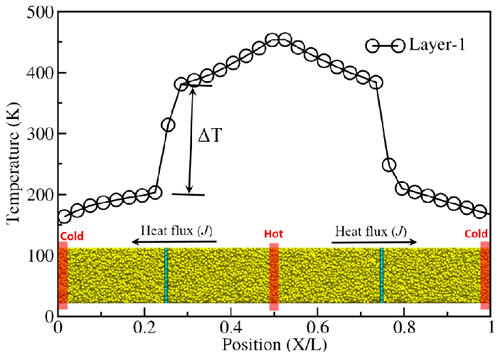当前位置:
X-MOL 学术
›
J. Phys. Chem. C
›
论文详情
Our official English website, www.x-mol.net, welcomes your feedback! (Note: you will need to create a separate account there.)
Enhancement of Thermal Energy Transport across the Gold–Graphene Interface Using Nanoscale Defects: A Molecular Dynamics Study
The Journal of Physical Chemistry C ( IF 3.7 ) Pub Date : 2018-01-19 00:00:00 , DOI: 10.1021/acs.jpcc.7b09643 Sadanandam Namsani 1 , Jayant K. Singh 1
The Journal of Physical Chemistry C ( IF 3.7 ) Pub Date : 2018-01-19 00:00:00 , DOI: 10.1021/acs.jpcc.7b09643 Sadanandam Namsani 1 , Jayant K. Singh 1
Affiliation

|
Graphene–metal nanocomposites are promising materials to address the heat dissipation problems in nanoscale electronic and computing devices. A low resistance interface between metal and graphene contact is crucial for the development of highly efficient nanodevices. In this direction, we have investigated the thermal conductance (TC) across the gold–graphene interface for various thicknesses of the graphene layer and temperatures using molecular dynamics (MD) simulations. The TC is found to decrease with the increase in graphene layer number from one to three. Further increase in the number of layers has no effect on the TC. The TC is also found to increase monotonously with the temperature in the range from 50 to 300 K. However, there is no effect of temperature on TC beyond 300 K. In order to enhance the TC value, we have investigated the thermal transport in the defect mediated gold–graphene interface for various defect sizes and defect densities. TC is found to increase significantly with the increase in the vacancy defect size and density of defects in the graphene sheet. The TC obtained for graphene containing defects of size 2.24 and 3.16 Å at 300 K is found to be 5 and 26% higher than the TC obtained for defect free graphene. The vibrational density of states (VDOS) of interface forming materials shows that the defects in the graphene sheet enhance the out-of-plane low frequency vibrational modes within graphene. This process facilitates high vibrational coupling between the gold and graphene, and enhances the heat transfer across the interface. This demonstrates that the TC across the gold–graphene interface can be tuned by adjusting the defect vacancy size and density of the defects.
中文翻译:

使用纳米级缺陷增强跨金-石墨烯界面的热能传输:分子动力学研究
石墨烯-金属纳米复合材料是解决纳米级电子和计算设备中的散热问题的有前途的材料。金属和石墨烯接触之间的低电阻界面对于开发高效纳米器件至关重要。在这个方向上,我们使用分子动力学(MD)模拟研究了石墨烯层各种厚度和温度下金-石墨烯界面上的导热系数(TC)。发现随着石墨烯层数从一增加到三,TC降低。层数的进一步增加对TC没有影响。还发现TC在50至300 K范围内随温度单调增加。但是,温度超过300 K时,温度对TC没有影响。为了提高TC值,我们研究了缺陷介导的金-石墨烯界面中各种缺陷尺寸和缺陷密度的热传递。发现随着石墨烯片中空位缺陷尺寸和缺陷密度的增加,TC显着增加。发现在300 K时含有尺寸为2.24和3.16Å缺陷的石墨烯所获得的TC比无缺陷石墨烯所获得的TC高5%和26%。界面形成材料的状态振动密度(VDOS)表明,石墨烯片中的缺陷增强了石墨烯内的平面外低频振动模式。该过程促进了金和石墨烯之间的高振动耦合,并增强了跨界面的热传递。
更新日期:2018-01-19
中文翻译:

使用纳米级缺陷增强跨金-石墨烯界面的热能传输:分子动力学研究
石墨烯-金属纳米复合材料是解决纳米级电子和计算设备中的散热问题的有前途的材料。金属和石墨烯接触之间的低电阻界面对于开发高效纳米器件至关重要。在这个方向上,我们使用分子动力学(MD)模拟研究了石墨烯层各种厚度和温度下金-石墨烯界面上的导热系数(TC)。发现随着石墨烯层数从一增加到三,TC降低。层数的进一步增加对TC没有影响。还发现TC在50至300 K范围内随温度单调增加。但是,温度超过300 K时,温度对TC没有影响。为了提高TC值,我们研究了缺陷介导的金-石墨烯界面中各种缺陷尺寸和缺陷密度的热传递。发现随着石墨烯片中空位缺陷尺寸和缺陷密度的增加,TC显着增加。发现在300 K时含有尺寸为2.24和3.16Å缺陷的石墨烯所获得的TC比无缺陷石墨烯所获得的TC高5%和26%。界面形成材料的状态振动密度(VDOS)表明,石墨烯片中的缺陷增强了石墨烯内的平面外低频振动模式。该过程促进了金和石墨烯之间的高振动耦合,并增强了跨界面的热传递。



























 京公网安备 11010802027423号
京公网安备 11010802027423号